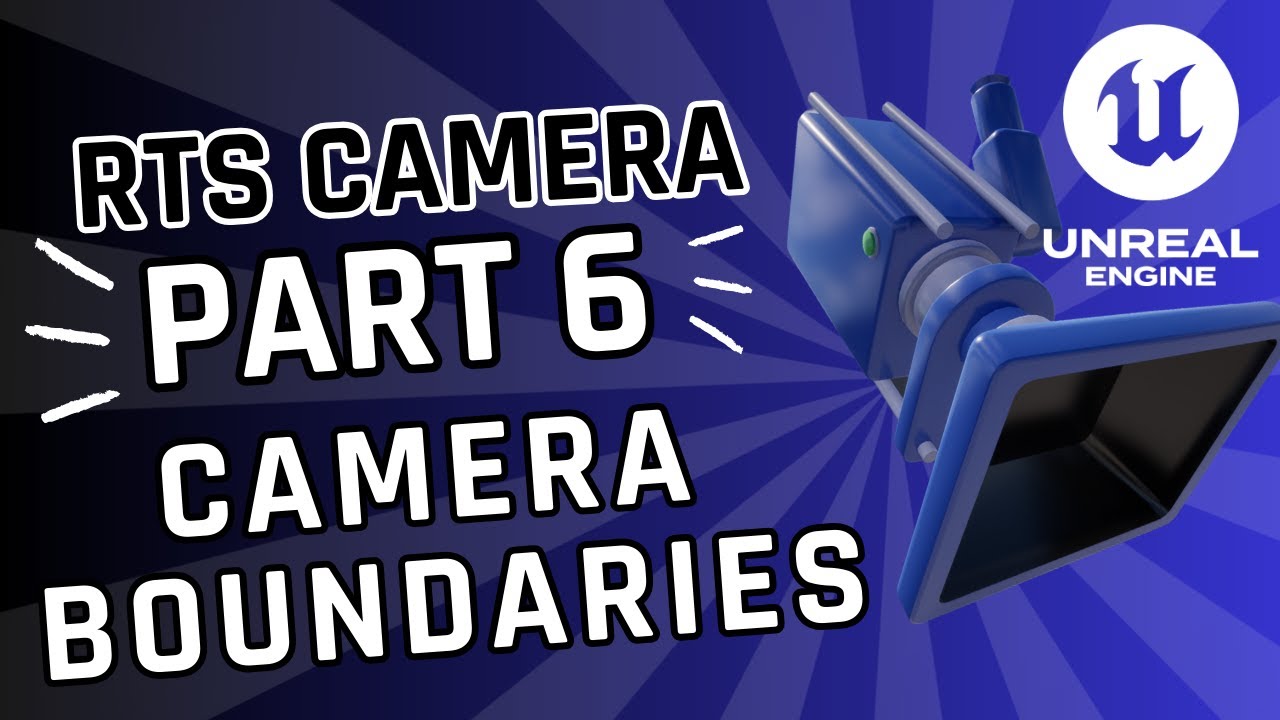
Part 6 – RTS Camera Boundaries – Master Your Map's Limits!
Learn to set up clean RTS camera boundaries in UE5 using collision channels and blocking volumes—no math, just Blueprints.
Welcome back! In Part 6 of the RTS Camera Series, we’re tackling something every strategy game needs:
map boundaries that stop the camera from wandering outside the playable area.
This idea came directly from the community — shoutout to @UnlessItsCrap for the request.
We’ll build a collision-based solution that requires no clamping math or messy calculations.
By the end, your camera will be fully locked inside the map, and you’ll have a clean, scalable system that works with everything we’ve built so far.
🎯 What You’ll Learn
- Create a dedicated collision channel just for your RTS camera pawn
- Use a Box Collision as the pawn’s root for accurate blocking
- Configure custom collision presets that only affect your camera
- Enable Sweep movement for smooth stops against boundaries
- Place and scale Blocking Volumes to form invisible map edges
- Test and duplicate walls until your entire map is enclosed
📝 Chapters
- 0:00 – Intro & what we’re building
- 0:06 – Subscribe reminder
- 0:10 – Viewer request credit
- 0:17 – Overview of the “no math” method
- 0:24 – Collision channel setup
- 0:40 – Finding collision settings in Project Settings
- 0:55 – Creating RTS Pawn channel
- 1:11 – Adding Box Collision to BP_RTSPlayer
- 1:22 – Why the box is the camera’s “body”
- 1:32 – Custom collision presets
- 1:54 – Sweep option in Set Actor Location
- 2:19 – Box Extent for accuracy
- 2:43 – Adding Blocking Volume
- 2:54 – Positioning first boundary
- 3:06 – Scaling Brush Settings
- 3:28 – Collision setup on Blocking Volume
- 3:44 – Testing boundary wall
- 3:52 – Duplicating for all sides
- 4:07 – Enclosed playable area
- 4:17 – Outro & next tutorial preview
- 4:28 – Call for feedback
- 4:46 – Subscribe wrap-up
⚙️ Step 1: Create a Custom Collision Channel
- Open Project Settings → scroll to Engine → Collision.
- Under Object Channels, click New Object Channel.
- Name it:
RTS_Pawn - Default Response = Block.
👉 This channel will be used only for our RTS camera pawn, ensuring boundaries affect it but not other actors.
⚙️ Step 2: Add Box Collision to Camera Pawn
- Open BP_RTSPlayer.
- Add a Box Collision component.
- Drag it above the current root and set it as the new root component.
This box becomes the physical body of the camera pawn.
📌 Why?
Instead of blocking the camera directly (which is awkward), we block this box. Boundaries will treat it like any other physical actor.
⚙️ Step 3: Configure Custom Collision
With the box selected:
- Collision Presets = Custom
- Object Type = RTS_Pawn
- Response to
RTS_Pawn= Block
This ensures blocking volumes tagged for RTS Pawns will stop the camera pawn, but won’t interfere with players, units, or other actors.
⚙️ Step 4: Enable Sweep on Movement
Earlier, we used Set Actor Location in Tick to move the pawn.
👉 Go back to that node and check Sweep.
Now Unreal will check collisions before moving the pawn, so it stops at walls instead of clipping through.
⚙️ Step 5: Adjust Box Extent (Optional)
To match your camera footprint more precisely:
- Select Box Collision → Box Extent
- Example:
X=300, Y=300, Z=32
These values define the “hitbox” of your camera pawn. Adjust to fit your game’s top-down view.
⚙️ Step 6: Add Blocking Volumes
- In the Main Map, go to Quick Add → Volumes → Blocking Volume.
- Place it where you want your first boundary wall.
- Example:
Location: X=0, Y=2000, Z=0
- Example:
- Scale via Brush Settings:
- X =
7000 - Y =
200 - Z =
10000
- X =
This ensures the wall is tall enough that the camera pawn can’t climb or slip over it.
⚙️ Step 7: Collision Setup on Blocking Volumes
With the Blocking Volume selected:
- Object Type = RTS_Pawn
- RTS_Pawn Response = Block
👉 Now this volume specifically blocks the camera pawn, leaving other gameplay actors unaffected.
⚙️ Step 8: Test & Duplicate
- Hit Play and move toward the wall.
- The camera pawn should stop cleanly at the edge.
- Duplicate the Blocking Volume (
Alt + Drag) and place 3 more walls for all map edges. - Scale them until the entire playable area is enclosed.
✅ Final Result
- RTS Camera is locked inside the map.
- No math, no vector clamping, no jittery logic.
- Fully collision-based → lightweight and easy to debug.
- Works seamlessly with WASD movement, Zoom, and Rotation from earlier parts.
🔮 Next Up
In Part 7, we’ll cover edge mouse movement, a classic RTS feature where the camera moves when your mouse touches the edge of the screen.
🔗 Resources
- 📂 Download Project Files (GitHub)
- 📺 Full RTS Camera Series Playlist
- 🌐 rambod.net
- 📚 Unreal Engine 5.6 Docs
📺 Watch the full tutorial here:
👉 https://www.youtube.com/watch?v=2ZJiGCw7IiI